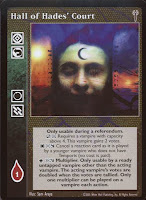- How many cards do you need to accomplish a particular feat (e.g. bleeding for 4)? This can be done by two "Computer Hackings" or one "Intimidation". So in the VtES game, "Intimidation" is more "card efficient" than "Computer Hacking", since "Intimidation" only requires one card and one action instead of two of each when using "Computer Hacking". This doesn't mean "Computer Hacking" is bad card, since "Intimidation" requires a Discipline ("Presence) whereas "Computer Hacking" can be played by virtually any minion.
When testing this type of card efficiency you can use the "1 blood = 1 pool = 1 action = 1 card" paradigma. A disciplineless card usually meeting this paradigma, i.e. "Lucky Blow" deals an extra point of damage (though with a drawback), "Computer Hacking" offers a bleed action a +1 bleed. Cards with requirements should meet the paradigma when used on inferior discpline level and exceed it when used on superior discpline level to be an average card. - How many cards do you need to cope with a given game situation? With the limited handsize in VtES it is always good to have versatile cards, which can be used in radically different ways. So your able to handle two (or more) situations without the need for drawing extra cards.
This versatility can be accomplished most easily by combination ("combo") cards. In the narrow sense a combo cards are cards which are two alternate cards types at the same time, e.g. "Scapel Tongue" can be used either as "Reaction" or as "Action Modifier" card. In a broader sense (which I will use from now on), a combo cards is card which can be used in two different ways in terms of what it tries to accomplish. E.g. "Govern the Unaligned" used at inferior or superior "Dominate" is an action card. On the other hand it can be used to your prey and or to generate blood on a crypt card. So in the definition I gave above, I consider it a combo card.
Example of strong combo cards
- "Murmur of the False Will" -- the new rising star in the world of combo cards. It offers a bleed +1 action modifier at inferior as well as a bleed bounce at superior "Dominate". What makes it strong is the fact that the other "Dominate" bounce cards do not offer this dual usuability and in a heads-up situation, the player needs to discard the card, since he can longer use the bounce effect of the card.
- "Swallowed by the Night" -- can be used either as maneuver to get the desired range for the combat or to evade a specific range which is required by the opposing minions strike. Or as action modifier to make an action successful, i.e. entering combat or bleeding. So the card can be good choice both in a "Beast, The Leatherface of Detroit" Rush combat deck, as well as in Stealth Politics deck.
- "Govern the Unaligned" -- the classic combo card (although both are actions); you can either make direct pool damage by bleeding at +2 bleed or generate indirectly 3 pool for yourself.
- "Resist the Earth's Grasp" -- highly versatile card, since it gives the vampire using the card a maneuver and/or press in a combat at interior "Celerity" and a (relatively) +1 stealth.
- "Sense the Sin" -- a +1 intercept reaction card and a bleed modifier for the "Daimonium" discipline.
- "Random Patterns" -- although the card offers +1 intercept at inferior "Auspex" and "Dementation", which is ok, but the superior effect requiring superior "Auspex" and "Dementation" of giving the blocking minion only -1 intercept is just too weak. "Dementation" can provide +1 stealth alone and sometimes combined with another effect, e.g. "Deny" or "Confusion". This makes "Random Patterns" a sub-standard card.
- "Purification" -- this is weak combo cards, although it offers two different effects to use, both of them (adding +1 life to an ally or causing a (D) action requiring "Presence" or "Dominate") are just weak or cornercase.
 Outferior cards
Outferior cardsCards requiring bloodlines disciplines have beside the usual inferior and superior usage of that bloodline discipline always an inferior discipline usage for one of the "common" disciplines. This effect is called the "outferior" effect/level. So if you pick a card for use in a bloodline based deck, you should consider the bloodline discipline effect first, but always take a look at the outferior effect.
Examples of good multi-discipline cards
- "Hall of Hades' Court" -- actually has three useful effects, can give a vampire with "Dominate" two additional votes, can cancel a reaction card at inferior "Temporis" and doubles another vampire's vote at superior "Temporis". So quite a neat package afterall.
- Clotho's Gift -- also a "Temporis" card which offers three different uses. At outferior ("Obfuscate") it offers a unique effect which otherwise only clan-based cards (like "Mesu Bedshet") or master cards like ("Effective Management") can achieve. At inferior "Temporis" the card serves as (indirect) pool gain, whereas the superior "Temporis" effect grants a conditional untap like "Homunculus" or "Metro Underground".
No comments:
Post a Comment